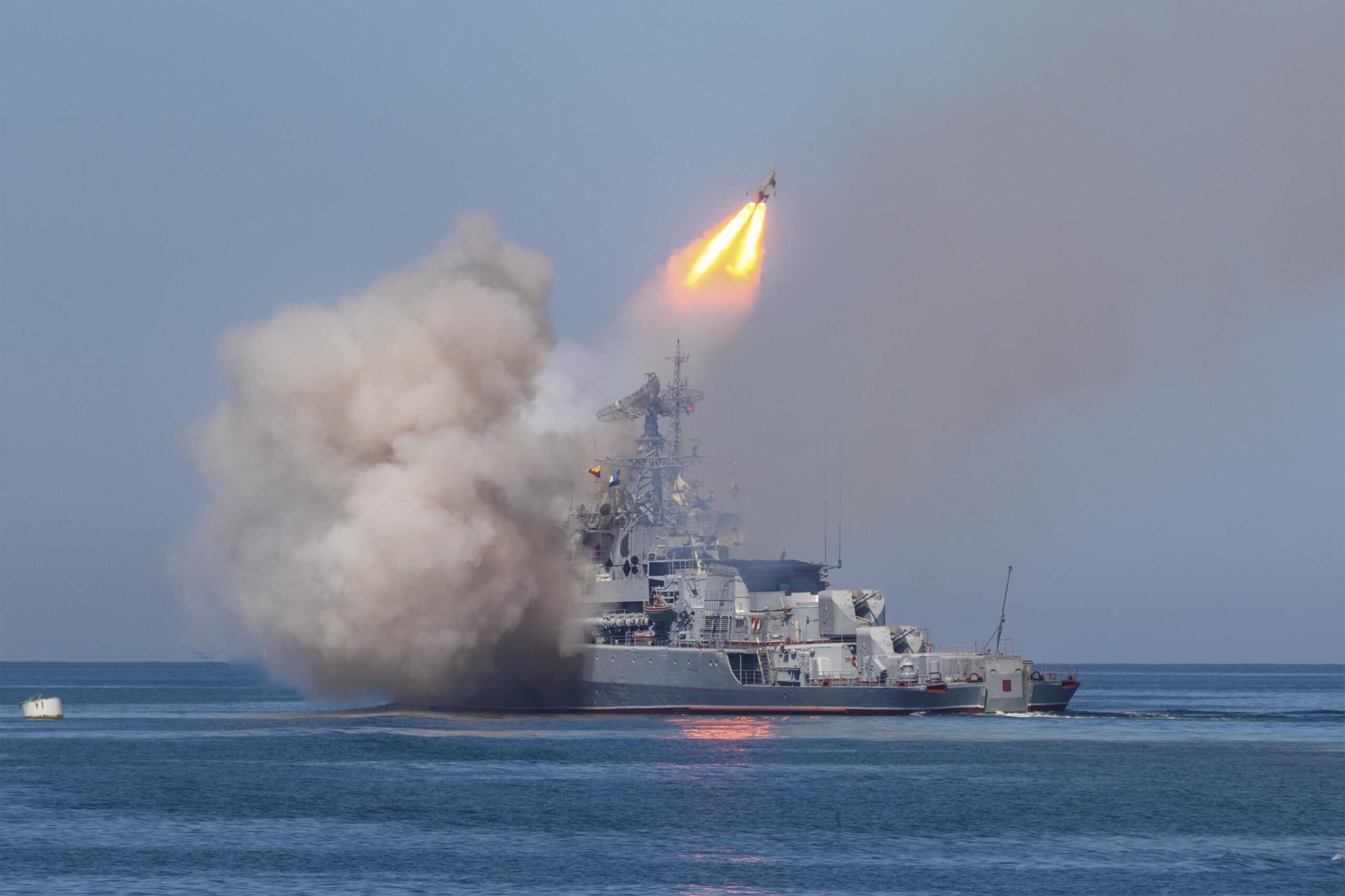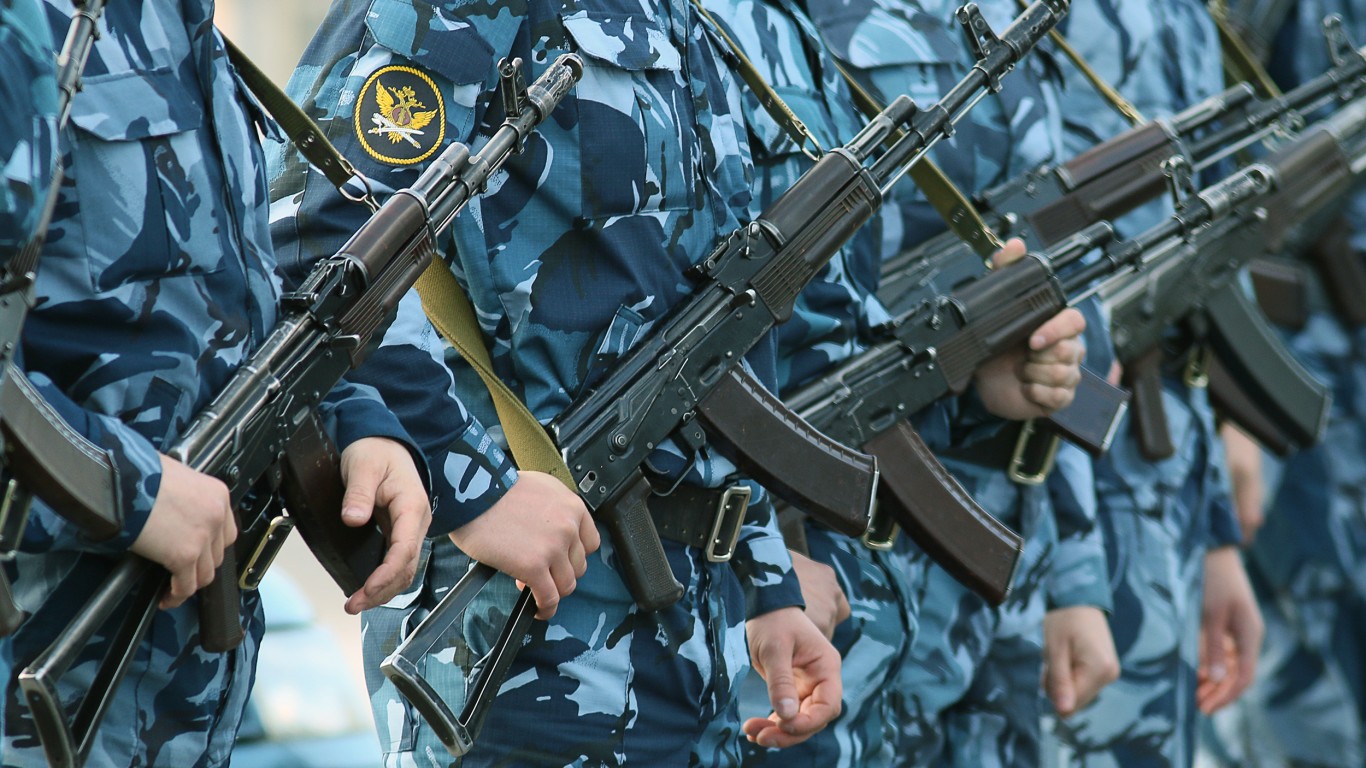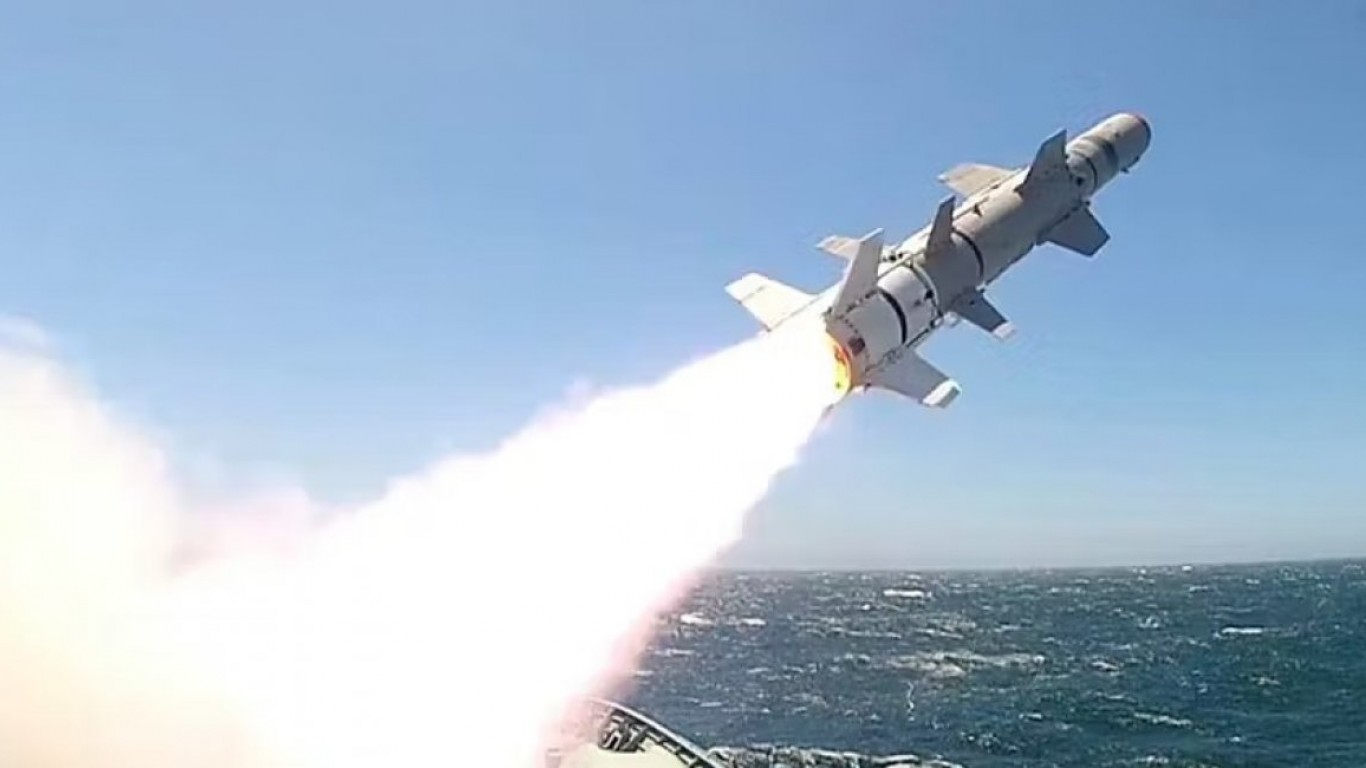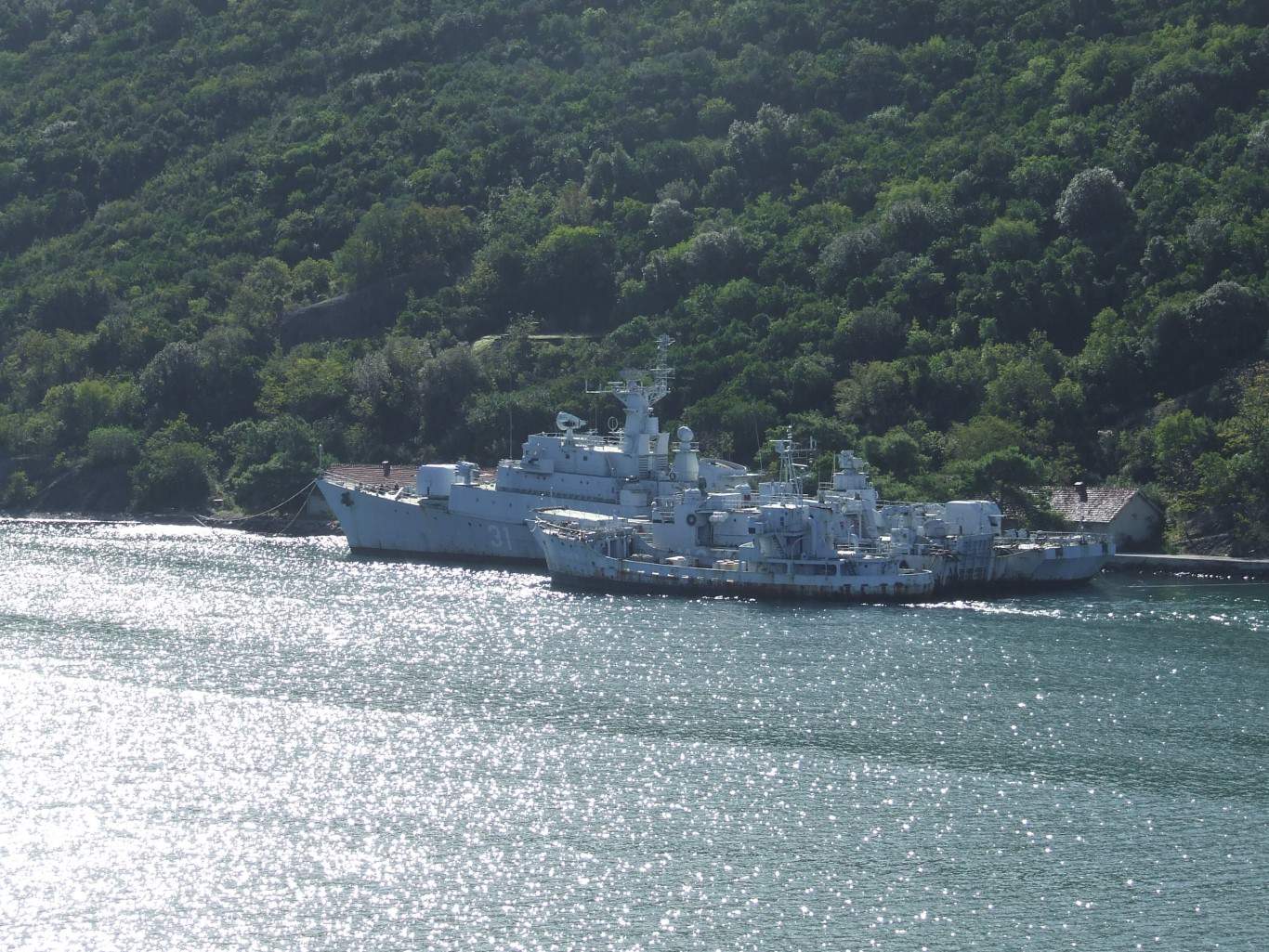
24/7 Wall St. Insights:
- Russia owns one of the strongest naval forces on the planet
- Russia’s annexation of Crimea in 2014 gave way for a warm deepwater port in the form of Sevastopol, further increasing Russia’s power within the region
- Recent additions to Russia’s navy like the Borei-class submarines and Admiral Grigorovich-class frigates further empower Russia’s naval ambitions
- Also: Dividend legends to hold forever
Building on decades of strategic planning, geopolitical maneuvering, and military investment, Russia has risen as a global military superpower. The Russian Navy, in particular, has cemented its position as one of strongest navies in the world, especially in Eastern Europe, by a long shot. (These are the 31 warplanes of the Russian Air Force.)
This dominance is not just a matter of military might but also reflects Russia’s broader ambitions in the region, particularly in the context of its ongoing conflict with Ukraine, even dating back to 2014.
Russia’s annexation of Crimea in 2014 gave way for a warm deepwater port in the form of Sevastopol, further increasing Russia’s power within the region. This base is not only a crucial operational hub for Russia’s Black Sea Fleet but also allows Russia to project power into the Mediterranean and beyond.
The newest additions to Russia’s fleet are fairly impressive, replacing older Soviet-era warships and submarines. The Admiral Grigorovich-class frigates which were introduced in the last decade are equipped with advanced missile systems and designed for air defense, anti-submarine warfare, and surface combat operations.
At the same time, the Borei-class ballistic missile submarines are further expanding Russia’s nuclear capabilities. Reportedly, the arrival of this new class of Borei submarines will enable the Russian Navy to resume strategic patrols in southern latitudes that supposedly had not seen a Russian missile submarine for 20 years. (Every Russian aircraft carrier throughout history.)
All of this is why NATO is making such a push in favor of supporting Ukraine, without supposed outright involvement. Cold War ambitions are coming to light again, for NATO containment, for Russia expansion. Considering Russia’s formidable naval fleet, NATO has reason for concern.
24/7 Wall St. is taking a closer look at the navies at large in Eastern Europe. To identify the Eastern European countries with the most military ships and submarines, 24/7 Wall St. reviewed 2024 Military Strength Ranking from Global Firepower, an annually updated defense-related statistics website with information on 145 countries. Countries were ranked on the total number of military ships and submarines in their fleet. We included supplemental information regarding submarines, aircraft carriers, destroyers, corvettes, patrol vessels, and frigates, as well as each country’s overall military strength score. We excluded countries that did not have any naval vessels.
Here is a look at the largest naval forces in Eastern Europe:
Why Are We Covering This?

Understanding the military dynamics of Eastern Europe is essential due to the region’s critical geopolitical importance, not to mention the ongoing conflict. Eastern Europe has historically been a focal point of tension, and military power plays an important role in maintaining both political and economic stability. The stability of Eastern Europe remains vital to global security.
6. Montenegro
- Total naval vessels: 13
- Frigates: 0
- Corvettes: 0
- Destroyers: 0
- Submarines: 0
- Patrol vessels: 5
- Mine warfare: 0
- Military strength score and world rank: 2.9109 – #129 out of 145
Montenegro comes in as one of the most recently established navies in Eastern Europe, or Europe in general, and for that matter one of the smallest as well. The Montenegrin Navy was established in 2006 following the country’s independence. With less than two decades under its belt, there’s a glaring reason why this navy is so small. Also limited coastline diminishes the need for a navy at large.
The fleet consists of only 13 vessels, with the majority as smaller patrol vessels. These are primarily used for coastal surveillance or search and rescue operations. The other vessels within the fleet are composed of support vessels like tugboats and motor sailboats, which are typically used for training or logistics.
Historically, Montenegro’s naval assets were inherited from the former State Union of Serbia and Montenegro, with most equipment dating back to the Yugoslav era. Although the fleet has seen minimal modernization, there have been recent efforts by Montenegro to add to its numbers. Notably, this year, the Montenegrin Navy expressed interest in procuring offshore patrol vessels from its NATO ally, France.
Despite its small size, the Montenegrin Navy is strategically important as a NATO member, much less its own national security. Montenegro boasts a coastline of roughly 180 miles.
5. Romania

- Total naval vessels: 20
- Frigates: 3
- Corvettes: 7
- Destroyers: 0
- Submarines: 0
- Patrol vessels: 3
- Mine warfare: 5
- Military strength score and world rank: 0.7712 – #47 out of 145
Historically, the Romanian Navy played a significant role in a few conflicts, namely its War of Independence and the following World Wars.
Although not the smallest fleet on this list, Romania currently operates a fairly modest fleet with 20 vessels in its service. Even considering its small size, it operates some fairly large vessels including a number of frigate and corvette class warships.
Like many other navies worldwide, the Romanian Navy is undergoing modernization efforts. Considering its regional security concerns, this is not a bad idea. Romania has engaged with France, its NATO ally, in terms of procuring some new vessels including offshore patrol ships, minesweepers, and even Scorpion-class submarines.
As a NATO member, Romania’s naval forces are fairly important to the alliance’s strategy at large in the Black Sea. Rising tensions in the region give credence to this, but again NATO’s involvement is a touchy subject.
Despite budgetary constraints, Romania continues to invest in modernizing its fleet. With the help of its allies, this should not be a big problem going forward. Also considering the alliance’s push for regional security, Romania may see a capital influx in its military forces, or specifically its navy.
4. Bulgaria
- Total naval vessels: 40
- Frigates: 4
- Corvettes: 3
- Destroyers: 0
- Submarines: 0
- Patrol vessels: 2
- Mine warfare: 12
- Military strength score and world rank: 1.0132 – #62 out of 145
The Bulgarian Navy, as part of the Bulgarian Armed Forces at large, operates a fleet that includes 40 naval assets. The fleet is comprised 4 frigates, 3 corvettes, 2 patrol vessels, and 12 mine warfare ships, among a host of support vessels.
Bulgaria stands in an interesting position, historically speaking. Its navy played roles in both World Wars and then in the Cold War, where it aligned with the Soviet Union. However, Bulgaria only recently aligned itself with NATO in 2004. Since then, it has participated in a number of international peacekeeping and security operations, on the side of NATO.
Like many other navies worldwide, Bulgaria is modernizing its fleet. The first of two MMPV 90 corvettes were launched by the Bulgarian Navy last year. And acquisitions were made in the early 2000s, adding frigates to its fleet from Belgium.
As it stands now, Bulgaria’s navy is hugely important for NATO’s strategy within the region. Keeping the peace in the Black Sea, considering tensions between Russia and Ukraine, is of the utmost importance for NATO, and thus for Bulgaria. Also, further modernization of its fleet could be helped on by its NATO allies.
3. Poland

- Total naval vessels: 45
- Frigates: 2
- Corvettes: 2
- Destroyers: 0
- Submarines: 1
- Patrol vessels: 3
- Mine warfare: 21
- Military strength score and world rank: 0.2917 – #21 out of 145
Located in the northern half of Eastern Europe, Poland is not necessarily privy to the ongoing action in the Black Sea. However, it is a major player in the Baltic Sea. Poland also boasts one of the strongest overall military forces in the region.
With a navy consisting of 45 vessels total, Poland operates 2 frigates, 2 corvettes, 1 submarine, 3 patrol vessels, and 21 mine warfare ships, as well as a host of other support ships. Overall, the structure of Poland’s Navy reflects an emphasis on coastal defense and maintaining a formidable presence in the Baltic region.
Historically, the Polish Navy played significant roles in key conflicts over the last century. During World War II, despite being vastly outnumbered, the Polish Navy made contributions to the Allied efforts. Notably, Poland sunk the German battleship Bismarck and helped in the D-Day landings.
In the modern era, Poland joined up with NATO in 1999. This shifted priorities for the Polish Navy from merely coastal defense to building a presence in the region as part of a larger international effort.
Recent modernization efforts within the Polish Navy include the construction of Miecznik-class frigates, which are expected to enter service in 2029.
2. Ukraine

- Total naval vessels: 104
- Frigates: 0
- Corvettes: 0
- Destroyers: 0
- Submarines: 0
- Patrol vessels: 33
- Mine warfare: 3
- Military strength score and world rank: 0.2598 – #18 out of 145
Coming in with the second largest navy in the region is Ukraine, which operates a fleet of 104 vessels. Although it should be noted, the conflict with Russia is ongoing so this number may be subject to change. Ukraine’s navy consists of 104 vessels, with most in service of coastal defense.
Ukraine’s current problems started in 2014 when Russia annexed Crimea, which also resulted in the loss of several key naval assets. The ongoing conflict, since 2022, has resulted in serious materiel losses, but despite this, Ukraine still has one of the larger fleets in the region.
Even withstanding this, the Ukrainian Navy has been actively rebuilding and modernizing its fleet. Efforts include the acquisition of new vessels to protect Ukraine’s coastline along the Black Sea.
The ongoing conflict with Russia has highlighted the importance of having a naval presence, especially in terms of securing the Black Sea region and supporting broader military operations.
It should be noted that although Ukraine is not a part of NATO it has been receiving assistance from the alliance. This has further stoked tensions between Russia and its NATO neighbors like Bulgaria, Romania, Poland, and Montenegro. Still as the conflict is ongoing, some analysts suggest there might be an end in the near future while others are not as hopeful.
1. Russia

- Total naval vessels: 781
- Aircraft carriers: 1
- Frigates: 12
- Corvettes: 83
- Destroyers: 14
- Submarines: 65
- Patrol vessels: 122
- Mine warfare: 47
- Military strength score and world rank: 0.0702 – #2 out of 145
Russia is known as having one of the biggest and baddest militaries on the planet, and that goes for its Navy too. The Russian Navy has 781 vessels, more than every other nation on this list combined. Russia also has the only aircraft carrier of this group.
The Russian Navy is spread across four main fleets: the Northern Fleet, Pacific Fleet, Baltic Fleet, and Black Sea Fleet. The Eastern European region really only sees two of these fleets.
In terms of its navy at large, Russia’s fleet includes 1 aircraft carrier, 12 frigates, 83 corvettes, 14 destroyers, 65 submarines, 122 patrol vessels, and 47 minesweepers, among a host of support ships.
Despite having the solo aircraft carrier in this region, the Admiral Kuznetsov, Russia’s crown jewel has faced numerous challenges over the years and has been in disrepair. It is expected to return to service sometime in the coming year, but it’s possible that more issues could arise.
Even withstanding setbacks with the Admiral Kuznetsov, Russia’s navy has undergone serious modernization in recent years, with new classes of submarines and surface ships entering the service. Notable additions include the advanced Borei-class ballistic missile submarines and Admiral Grigorovich-class frigates.
Historically, the Russian Navy was a key player in both World Wars and the Cold War, maintaining naval superiority in the Arctic, Pacific, and Black Sea regions.
The ongoing conflict with Ukraine has been a test on land, but when it comes to the open sea Russia is the strongest in the region by far.
Take This Retirement Quiz To Get Matched With An Advisor Now (Sponsored)
Are you ready for retirement? Planning for retirement can be overwhelming, that’s why it could be a good idea to speak to a fiduciary financial advisor about your goals today.
Start by taking this retirement quiz right here from SmartAsset that will match you with up to 3 financial advisors that serve your area and beyond in 5 minutes. Smart Asset is now matching over 50,000 people a month.
Click here now to get started.
Thank you for reading! Have some feedback for us?
Contact the 24/7 Wall St. editorial team.


